
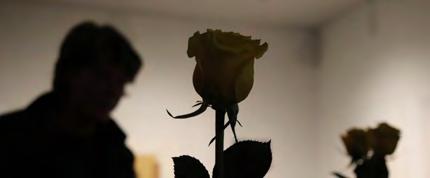

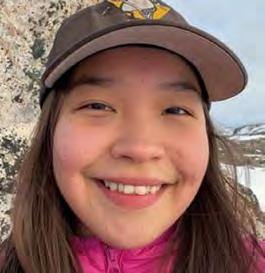


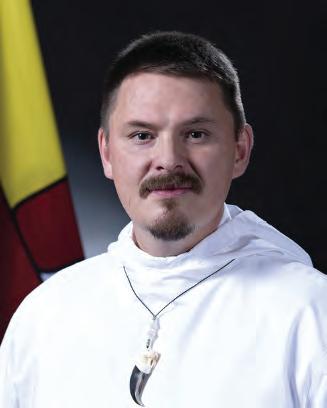
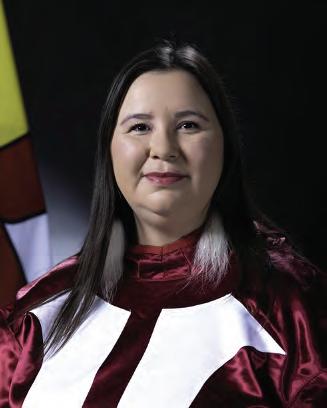

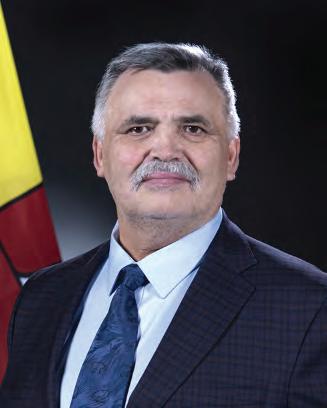
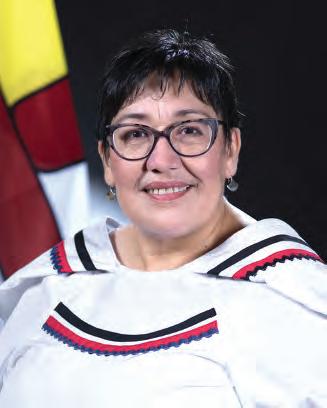

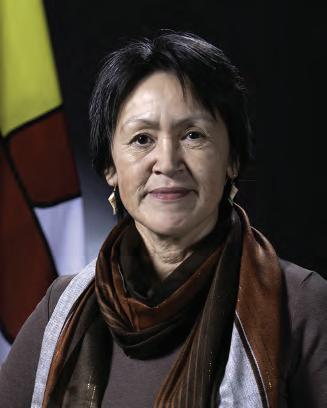

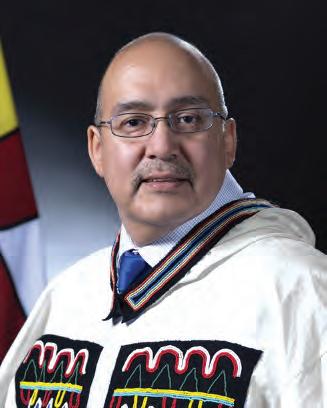






















presented, for the small fee of $5.

Infiniti Goddess Zeus Tyson Legend is a man who was born and raised in Iqaluit.

Originally named Adamie Ellsworth, he first decided to change his name in 2016 to Tyson David Naulaq.
“It’s not hard here in Iqaluit, you just go to court and fill out an application. It only took one week the two times I’ve done it,” says Legend.
Based on Nunavut Courts website, it only takes two valid pieces of identification along with a birth certificate and a $10 fee to file an application.
After individuals have applied to change their names, anyone can apply to object to the name change as long as a valid reason is
The second time Legend changed his name was in 2019. When asked why he chose the name, he simply answered: “I like the great names!”
Compared to other provinces and territories, Nunavut has few laws restricting the name change process. While provinces such as Alberta require every individual changing their names to retain at least one part of it related to their family for identification, the “Consolidation of Change of Name Act R.S.N.W.T. 1988,c.C-3,” which is applicable in Nunavut, does not include such restrictions.

“I know someone who changed his name to Bruce Wayne,” says Legend. “You can change your name as many times as you want.”
Legend, however, has seemingly found the name that he plans to retain because he said he has no plans to change it ever again.

which provide food for fish.
opportunities can still take place “on a certain level.”
Prime Minister Justin Trudeau last week announced $800 million in funding over seven years for large Indigenous-led conservation projects covering almost a million square kilometers of land.
Four major protected areas have been announced throughout Canada, which includes one in the Qikiqtani region of Nunavut. The Qikiqtani zone was selected based on its vast terrestrial and marine biodiversity. Animals present in the region include birds, fishes, seals, whales, walruses, polar bears, and an abundance of plankton and copepods, crustaceans
The projects, meant to conserve land and protect coastal and inland waterways, will be funded starting next year.
“Collectively, all current and proposed protected areas in the Qikiqtani represent approximately 23.15 per cent of terrestrial and 30.75 per cent of all marine protected areas in Canada,” states a report on the Qikiqtani Inuit Association’s website.
Trudeau hopes this new initiative will help Canada reach its target of conserving 25 per cent of the country’s land and waters by 2025, and then 30 per cent by 2030.
The new zones will be considered as protected, though the prime minister says mining projects and other development
“There is a market for it, because we do not want to depend on authoritarian countries for our resources,” he said.




Trudeau explained that he wants the conservation projects to be led by Indigenous communities.
“It is the Indigenous communities who will be part of the discussion to chose which zones should we protect and which zones has room for development, and to what conditions,” he said.
The announcement came after attending the COP15 (Conference of the Parties), a convention on biological diversity in Montreal.













After the animated children’s movie Sedna, Empress of the Sea was released on Nov. 7 at the Astro Theatre in Iqaluit, some viewers were critical of what they said were inaccuracies in the film.

Andrea Andersen, sent an email to producers to share her concerns about the lack of Inuit consultation during production of the film and how she thinks it resulted in various cultural flaws.
In an interview with Nunavut News, Jerry Thevenet, the movie producer and founder of Jerryco Animation, says the animation studio heard the critics, and explains how they are going to respond.
Q: Some people have been saying the animation was not culturally appropriate for various reasons.
A: Yes, a few people in Iqaluit thought that it was going to be the traditional legend of Sedna the goddess of the sea and were quite surprised that it wasn’t.

Q: I heard that you would delay premieres down south until critics are heard. Is that true?
A: Yes, we are delaying the official release until we find a way to address everyone’s concerns. One of the parents from Iqaluit that reached out to us was kind enough to send us a list of organizations that she thought might help. We are following up with some of them now, in addition to reaching out to members of our community and discussing the matter with colleagues.


Q: Could you tell me more about the research you’d done before creating this movie?
A: Sedna, Empress of the Sea is based on a story my grandmother told me when I lived with her as a young boy in Labrador (NunatuKavut) in the 1960s. It wasn’t meant to be the retelling of the traditional Inuit legend from Nunangat, nor a real life depiction of Inuit people, traditions or culture. It was a reflection of my culture, my community and the stories that we share.
Q: Are there details you feel might have to be changed?
A: That is a great question. I share a unique cultural heritage with a very small group of people. We are a mix of both European and Inuit ancestry who historically referred to ourselves as Labrador Métis, but now call ourselves Inuk from NunatuKavut. Ours is like no other Indigenous culture I know. We live in an isolated community that traditionally ate caribou instead of beef, sewed mukluks and sealskin parkas, tended traplines and fishing nets, picked spruce gum and red berries, and ate hardtack and bannock we called “ flummy dums.” We live and understand two distinct ways of life. It is a beautiful culture and I cherish it deeply. Sedna, Empress of the Sea is a reflection of this unique culture and its storytelling.
Q: From which part of Canada is this version of Sedna based out of?




A: Happy Valley, Goose Bay, Labrador (NunatuKavut)
Q: Is there something you would have done differently in production?

A: Indigenous people in Canada are not one homogeneous group. We are a collection of distinct communities, each with its own traditions, languages and stories to tell. In making Sedna, Empress of the Sea, I tried to tell mine.
My grandmother was an excellent seamstress. When I was a kid, she used to make little sealskin figurines for me. When the huskies would eat them she wouldn’t tell me, she would just make me another one. One day she made a doll for one of my cousins. Instead of making it from scratch, she bought a plastic doll from the store and dressed it up to look like a little Inuit girl, complete with braids and face tattoos, so when she told me the story of Sedna that is how I imagined her.
I know muktuk is considered a delicacy among the Inuit, but probably not so by everyone else, so I thought why not use it for character transition. At first, Billy (a film character who has spent time down south) doesn’t want to eat this traditional food, but as the story unfolds he begins to like it, and by the end he is gobbling it up. That is him accepting his Indigenous culture, much like Sedna accepting that she is the ruler of the sea.
Of all the scenes in the film, the one I was most conflicted with was when Sedna and the caribou rub noses at the end. I knew this could potentially be controversial, but it is what my grandmother and I used to do before I went to bed, it was also a misconception that was prevalent in the ‘60s that I thought helped establish when the film takes place. Perhaps a disclaimer might have helped?
In hindsight, I would have let people know at the beginning of the film that it wasn’t going to be a traditional retelling of the Inuit legend of Sedna; that the storylines, characters and settings were how a six year old boy living with his grandmother in Goose Bay in ‘60s imagined them; that young Inuit girls don’t have face tattoos; that muktuk is actually quite delicious; and that Inuit people don’t rub their noses together when they kiss. I also would have let parents know that some of the themes, images and subject matter might require parental supervision.
Film wasn’t intended to retell traditional legend of empress of the sea, says Jerry ThevenetFelix Charron-Leclerc Local Journalism Initiative The animated children’s movie Sedna, Empress of the Sea premiered in November in Iqaluit. Not long after it showed at the Astro Hill Theatre, viewers started sending critiques of what they believed to be cultural inaccuracies. Image courtesy of Jerryco Animation A doll Jerry Thevenet’s grandmother made representing Sedna. “…she bought a plastic doll from the store and dressed it up to look like a little Inuit girl, complete with braids and face tattoos, so when she told me the story of Sedna that is how I imagined her,” says Jerry Thevenet, director of the animated film Sedna, Empress of the Sea. Photo courtesy of Jerry Thevenet
HALUUQQARIT . ALIANAQ QUVIAHUGVIK TIKILIQMAN QILAMINNUAQ. IQALUKTUUTIAQMIUTGUUK UPLAQINAHUAT. QUANA. TAMNA AANIARUT PINGMAN PINGGNITTUT IMANI. PINGUUKMATA IPAKHANI KAMIUNITTI HAMI. NIUVIPKAIVAKTUTLU ILIHAKVIKMIT. MIQHAITLU PINNITAK, PINNIQHANIKLU AITUTIKHANIKLU TUNIJUKHAT ALIANAQ. INUIN NIRIVAKTUTLU. MUUQPAUJAKHANIKLU MAMAGAALUK. ANGNAT MIQHUJUKTUT QUANA. ILANI ANURI AKHUUKPAKTUK PIQHIINNAQHUNILU. HIQINIQ QULVAJUITTUK ILANI. TAMMAQNAQHIJUK UDJIKLUNI TATKIHIUT NUTAMI ATULIQQAT. INUIN IQALLIQIVAKTUTLU. TUKTUITLU UMINGMAITLU QAKLIVAKTUT IQALUKTUUTIAMUT. ALIANAQ NUNA PINNIQHIJUQ PIHUJARIAMI. INUIN NAMMAINNAQTUT. NUTAQQAT ALIATTAKPALIKMIJUT QUVIAHUGVIK TIKILIQMAT. UMIKHIMANIAQTUT ILIHAKVIIT DECEMBER 16MI ANGMAKLUNI JANUARY 3MI. NAAMMAKPAKLUHI. QINIQPAKLUGIT ILATIT. Welcome to the little growing village of Cambridge Bay, Nunavut.

Winter has certainly settled in quickly on the island. Lots of snow already and snow storms come and go.
I think the sun will not rise now for a few weeks. It seems that the weather is milder too when there are no blizzard days.
Lots of snow makes it easier for hunters and fishers to head out on the ocean and the land to harvest food. Living by the Arctic Ocean is fun — you can walk for miles and enjoy nature, ice, snow and the fresh, brisk cold air.
One thing I am very proud of is my hometown of Iqaluktuutiak. It seems to be growing with more buildings coming up and a whole new part of town is full of new houses and buildings. We even have a beautiful brand new arena way up in the new part of town. We also have a brand new Nunavut Arctic College campus which comes with apartments for student housing and a beautiful kitchen for culinary courses.
Soon Christmas will be here, and the kids were scheduled to perform their annual Christmas concert at Kullik Ilihakvik on Thursday, Dec. 8. We as parents and grandparents always cannot wait for this show each year as we get to watch our beautiful children all dressed up to perform for their parents and community. Christmas concerts were postponed during the pandemic.
Schools will be shut down during the holidays for both Kullik Ilihakvik and Kiilinik High from Dec. 16 until Jan. 3. We hope all the students, teachers, staff and their families and the community have a safe holiday.

With the pandemic funds coming through for Nunavut beneficiaries, it sure helps with groceries and other much needed items. Food insecurity is for real in Nunavut. We have some of the highest food prices in the world.
It is sad to say this but it is true.
Also our lively little Co-op was busy with dividends after they held their annual general meeting in November. Many Ikaluktutiak Co-op members received dividends, for a total of $750,000. They pay out in two payments — the first is paid to each member after the AGMs in November of each year and then the second payment of dividends is distributed in December. Everyone loves this time of the year to be able to shop at our Co-op.
They also held elections and three new directors were sworn-in to sit on the Ikaluktutiak Co-op board. The new
president is David Kaosoni, the new secretary is Brent Nakashook, and Marie Luci Uvilluk joined the board. Karen Kamoayok remains vice-president for a two-year term and the remaining board members are Beverly Maksagak, Mona Taylor, James Panioyak, Emily Angulalik and Jessie Lyall.

Prize winners at the AGM included Jeannie Komaksiut, who won a trip to Edmonton, but she traded it to go Taloyoak instead; Christina Maksagak won a trip to the Kitikmeot; Marjorie Kemaktun got a TV; Ida Neglak won a tent; Doris Hokanak is the lucky owner of a new queensized bed; Mabel Etegik took home a new sewing machine
with Navalik Tologanak email: helent@qiniq.com
and Nancy Maghagak won a meat pack. Others were given turkeys.
We wish to once again, like every year, thank Angela our awesome Co-op manager and her staff for always making sure the store is open, well stocked and members are well taken care of. Oh, and yes, we have our Co-op Hotel, usually known as the Arctic Islands Lodge and now renamed Inns North. There’s a popular restaurant on site, when their staff is there. Please continue to support your Co-op, that way there’s no need to shut down. We can be successful.
God Be With You Son.

Downtown Cambridge Bay shines a little brighter with the spirit of the holidays. UUNA ENOKHONNOAK
PINNIRAALUK
IQALUKTUUTIAMI. QUVIAHUGVIK






There are eight finalists for the 2022 Arctic Inspiration Prize.
Of those contenders, five are from Nunavut and the NWT. With close to $3 million to be won by Northern initiatives, each project has the chance to make its own impact.


Three regional selection committees for Yukon, NWT and Inuit Nunangat have selected these finalists, who have stood out from the various submissions made to the Arctic Inspiration Prize Committee.
The Nunavut Arctic Inspiration Prize finalists are as follows:


-Kuugalak — Emily Angulalik, Cambridge Bay, $1 million finalist


Kuugalak seeks to build a campus in Cambridge Bay that will combine indoor and outdoor activities, community-designed production equipment and experiential landscaping to bridge green energy research and the growing of local plant species for nutrition, climate adaptation and cultural use.
-Pilimmaksaijuliriniq — Andriana Kusugak, Rankin Inlet, $1 million finalist
Pilimmaksaijuliriniq aims to be an Inuit-led and designed initiative for Inuit Nunangat in response to the National Inuit Suicide Prevention Strategy and other action plans. It proposes additional mental health supports in concert with Inuit wellness traditional teachings. It will look to support community organizations, activists and teachers to deliver community-based programming in Inuit Nunangat.
-Nunavut Youth Creative Collective — Macintosh Pavia, Iqaluit, Youth Prize finalist (up to $100,000)
The Nunavut Youth Creative Collective is seeking to help increase Inuit participation in advertising, social media and other digital formats to help represent Inuit in campaigns targeting Inuit.
The NWT Arctic Inspiration Prize finalists are as follows:
-Lessons from our Elders — Sharon Snowshoe, NWT, AIP Category finalist (up to $500,000)
Lessons from our Elders wants to engage high school students in the NWT in identifying historic artifacts cited in traditional stories, and interview an Elder. By working with 10 communities over a 10-year-period for one year, the project hopes to establish an expedition showcasing a part of the North that North-
erners don’t see very often.
-Northern Games Youth Collaboration Inuvialuit Piuyausiq — Tamara Voudrach, NWT, Youth Prize finalist (up to $100,000)
The Northern Games Youth Collaboration Inuvialuit Piuyausiq hopes to hold a Northern Youth Development Program in Tuktoyaktuk and to develop the next generation of leaders by promoting healthy activities and cultural connections, with a focus on youth mentorship and highlighting volunteerism.
“I’m excited to see the innovation and creativity of each of these teams take centre stage as we move back to an in-person ceremony in February as part of the Northern Lights Business and Cultural Showcase, where the winning laureates will be announced,” said Wally Schumann, chair of the Arctic Inspiration Prize Charitable Trust.
“These teams represent the hopes and dreams of their communities and I am thrilled that we will be able to celebrate them all as a community, together once again.”




















A new project is set to take place in Taloyoak, with the goal of teaching youth how to make traditional mittens.
Breanna Mannilaq is organizing a workshop, which is set to start on Jan. 7. The event was supposed to start earlier this year, but Covid delayed the process.

Mannilaq says that growing up, she was surrounded by people who knew all about traditional crafts such as this one.
“When I was in kindergarten, the staff of Netsilik School in Taloyoak would make us do the patterns ourselves from a very young age,” she recalls. “Our principal at that time always made sure a lot of our culture was passed down to us by filling the curriculum with activities that gave us a lot of knowledge. I also learned bits from my mother. It’s hard to say who I originally learned it from because there were so many people doing it when I was growing up.”
She’s afraid the growing influence of social media might replace cultural activities such as fashioning mitts. For that reason, she has decided to focus on older groups of students, to build a knowledgeable force in her community.
“The idea is to try and get youth involved, not only in making the mittens, but also reconnecting and helping each other,” she says. “After Covid hit, we’re all a bit more distant and disconnected. There

are so many trends on the internet; our identity is slowly going away. I wanted to bring it back. I want to give the workshop to the older youth especially, because I want them to be able to teach it themselves to their family and friends,” explains Mannilaq.
After promoting the project in her community, Mannilaq heard from numerous interested individuals between ages 11 and 19. The workshop, funded by Northern Youth Abroad
(NYA), is set to start when the organizer receives the crafting supplies at the beginning of 2023.



NYA is offering grants for other community projects for anyone interested in making a positive impact in their community.
Mannilaq says she’s excited to start the workshop and that “this will be a good opportunity to slow down for our culture, and it is a good way to refresh the mind.”

A decision to end vaccine mandates at the upcoming Arctic Winter Games had absolutely nothing to do with the Alberta government’s request and Alberta Premier Danielle Smith would not have been able to revoke $1.2 million in funding regardless. That’s from Arctic Winter Games International Committee (AWGIC) president John Rodda, who spoke to Inuvik Drum while snowed in at the Seattle-Tacoma International Airport Nov. 29. He said the decision was based


on advice from health authorities from multiple jurisdictions that it was safe to loosen restrictions.
“Originally when the policy was implemented, it was done with the advisement of the appropriate health authorities,” he said. “Ultimately, we arrived at what we had thought was the best policy, for the health and safety of all the athletes and participants coming from the circumpolar North. We took those directives and advisements and created the policy.
“But since then, things have relaxed — we understand that. So we deliberated and decided (removing the re-


quirement) makes sense — cautiously. But it was not driven by the Alberta premier in any shape or form.”
During a press conference Nov. 28, Smith suggested she convinced the Arctic Winter Games to drop its vaccine mandate for the Wood Buffalo 2023 games by threatening to cut off $1.2 million in funding for the upcoming youth event.

“The Arctic Winter Games wanted $1.2 million from us to support their effort and they were discriminating against the athletes, telling them they have to be vaccinated,” she said in a response to a question about vaccine mandates in the workplace. “So we asked them if they would reconsider their vaccination policy in the light of new evidence, and they did and I was pleased to see that.”
However, Rodda said the decision to remove the mandate had already been made after consultation with a variety of healthcare experts from participating nations and Smith basically called just in time to hear the news. He noted the $1.2 million in funding for the AWG was given to the Regional Municipality of Wood Buffalo in 20192020 by the now defunct Alberta Sport Connection and the Alberta government could not actually take it back.
He also stressed the AWGIC was paying attention to world health events and was completely open to reversing the policy if healthcare officials in participating jurisdictions were concerned
with Covid-19 numbers or other communicable diseases.
“We always take into account, first and foremost, the health and safety of the athletes and participants that come from the circumpolar North,” he said. “What we were working on was through the Covid-19 pandemic, but if we get directives that come from other health officials, nationally or provincially, that there is some other element that we have to contend with, then we are prepared to work with them to figure out what the best mechanism is to protect those people that are coming to the Games.
“We are not health officials or medical people. We’re trying to do the best we can for the health and safety of

Rodda added the AWG was making sure social distancing practices and sanitation procedures were in place in the Regional Municipality of Wood Buffalo, but there is no mask mandate at this time. He cautioned that that could change if health advice changed. He added the AWG had a contingency plan in the event of required isolation or other urgent scenarios.
On her first day in office, Smith declared people who chose to not get a Covid-19 vaccine were “the most discriminated group” she had witnessed in her lifetime. She has since walked back those comments, though has not apologized.


lett and her rink of Diane North, Robyn Mackey and Denise Hutchings flying the flag on the women’s side.


The national curling championship schedule motored on earlier this month as Nunavut was once again back on the ice to take on the country.



This time, it was the Everest Canadian Seniors Curling Championships in Yarmouth, N.S., which wrapped up on Dec. 10. Nunavut’s entries hailed from the Iqaluit Curling Club with Geneva Chis-




The men’s rink consisted of Peter Mackey and his team of Jeff Nadeau, Greg Howard and Jamie Gauthier.
As of press time, both teams were playing in the seeding pool after dropping all of their games in opening pool play. Here’s some of the action from last week.
Nunavut News is committed to getting facts and names right. With that goes a commitment to acknowledge mistakes and run corrections. If you spot an error in Nunavut News/North, call (867) 979-5990 and ask to speak to an editor, or email editorial@nnsl.com. We'll get a correction or clarification in as soon as we can.


After Stanley Anablak stepped down as president of the Kitikmeot Inuit Association (KIA) in October, Fred Pedersen, interim executive director, stepped up to fill the roll. Anablak’s presidency was due to expire this month.
The Kitikmeot Inuit Association is now holding an election for the positions of president and vice-president of social and cultural development on Monday, Dec. 12.
The candidates running for president are David Akoak (Iqaluit), Robert Greenley (Cambridge Bay), David Nivingalok (Kugluktuk), Simon Komangat (Gjoa Haven) and Simon Qingnaqtuq (Taloyoak).
As for the office of vice-president, Bob Aknavigak (Cambridge Bay) and Raymond Quqshuun Sr. (Gjoa Haven) are vying for that seat.
Both positions come with four-year terms.
Any Inuit residents of the Kitikmeot region who are 16 years and older and enrolled or eligible to enroll in the Nunavut Land Claims Agreement can vote on Monday.
A loaded fuel tanker rolled onto its side along the all-weather access road to Meadowbank mine at kilometre 87, according to Agnico Eagle.
The tanker, owned and operated by a contractor, rolled at approximately 3:15 p.m. Nov. 28.
“The driver was not hurt during the incident but was preventively transported to the site clinic
to be evaluated,” the mining company stated in a news release.

“The road was closed, and the emergency response process was initiated immediately. Emergency spill measures are being implemented by the Meadowbank Complex personnel and remediation actions are ongoing. At this time, no fuel has entered any freshwater body and the exact quantity of materials lost is being assessed. At the moment, it is estimated at 20,000 (litres).”
Federal and territorial authorities and the Kivalliq Inuit Association were notified of the incident. An analysis was being conducted to identify the cause of the spill.

A Royal Canadian Air Force C-130 Hercules brought toys to Iqaluit on Saturday, Dec. 3 as part of the annual Toys for the North initiative.
The toys in Iqaluit will subsequently be distributed to various communities around Nunavut.

Every year as part of the campaign, the Canadian Toy Association, RCMP and the Royal Canadian Air Force partner to help deliver toys to Nunavut communities. It total, $1 million worth of toys were delivered to Nunavut and the northern parts of Labrador, Manitoba and Ontario.
The City of Iqaluit held its 2022 Outstanding Volunteer Awards on Nov. 30. The winners for 2022 are as follows:
Ö±Ø ÜÒïùÖÒπ¿Í≤Ò. íò∏≤Ê›î í±ØÒπØÀ´ú ï·∆¿Ò ≤áfl≤, ÇÔ¬∆¬éî Çflˆ (867) 873-4031 Ö±Ø ÇÔÍ›ùÀجü ÜÒïúªÄ«, Ç„·√∏≥î Ô‰íÇÕúòî ééËͬéî Çflˆ editor@nunavutnews.com.ÜÒïùÖ˪∏≤ÖÒíflî Ç„·√∏≥î ∂¬∂ĉÖͬü áÀ∏∂ÒπêÖÊçí.



-Outstanding Volunteer in Sport and Recreation: Corey Skinner
-Outstanding Volunteer in Arts and Culture: Pits Alainga
-Outstanding Youth Volunteer: Akutaq Williamson-Bathory
-Outstanding Volunteer in Community Development: Jenni Bell
-The Great Helper Award: Seane d’Argencourt Printup
The city also distributed awards to volunteers who helped out during Iqaluit’s fuel water emergency last fall. They were Janet Brewster, Mike Salomonie, Sherri Robertson, Sean Clark, Joey Murdoch-Flowers, Joe Juralak, Julia Roberts and Nadia Ciccone.
Andrea Anderson received recognition for her work in the community as did various businesses and organizations who assisted during the water crisis.
“Your contributions to the community during this time were immeasurable and we want to extend our sincerest appreciation,” wrote Geoffrey Byrne, acting communications and customer service manager for the city.
Baker Lake’s municipal council announced through Facebook Dec. 3 that the community would be declared a prohibited area from Dec. 18, 2022 through Jan. 6, 2023.
During that time, importing alcohol into the community is not allowed.
The fuel tanker Kitikmeot W became the first ship to use Iqaluit’s newly built deep sea port. It pulled in during the very early hours of Thursday, Dec. 1 with the assistance of the CCGS Henry Larsen, an icebreaker from the Canadian Coast Guard. The Qikiqtaaluk W was also escorted into Iqaluit’s harbour. The vessels departed from the area a few days later. Trevor Wright/ NNSL photo


Noel Kaludjak wants to build stronger family structures, reduce family violence and heal from the past – and to do that, he’s pursuing a new men’s organization.
“We are affected by our past,” said Kaludjak, originally born in Arviat, having lived in Whale Cove and now settled in Rankin Inlet.
“When we were moved into the communities, our lives changed. When they sent us to residential school, our lives changed. We need to get that back. It’s for my children, for my grandchildren, for my great grandchildren.”
Other men’s programs – like one he was involved with in Coral Harbour that started in 2009 – have largely fizzled out due to lack of funding or resources, he said. Kaludjak has been spending the last few years wondering how to create a strong and successful men’s group that has more longevity.


“I think possibly the only best way is to create a standalone men’s organization, a society for men, run by men, operated by men,” said Kaludjak. “No outside rules, regulations.”
He’s starting with a board of several men, including representation from different age groups and Elders. His intention would be to develop policies such as confidentiality for those meeting, plus training programs, on-the-land programs, tool-making classes and similar.
“There are so many men out there who have great ideas,” he said.
He has some men committed to the organization already, but he’s now on the hunt for someone who could work as secretary treasurer, running the finances and creating proposals for funding.
“That’s what we’re really looking for right now,” he said.
It’s not off the ground yet and it could be some time until the pieces come together. For now, Kaludjak is looking for interested men to help get plans in motion.
“We need to start somewhere,” he said. “I want to start in Rankin as a small organization first and let it grow from there.”
Anyone interested in helping can contact Kaludjak directly.




























































